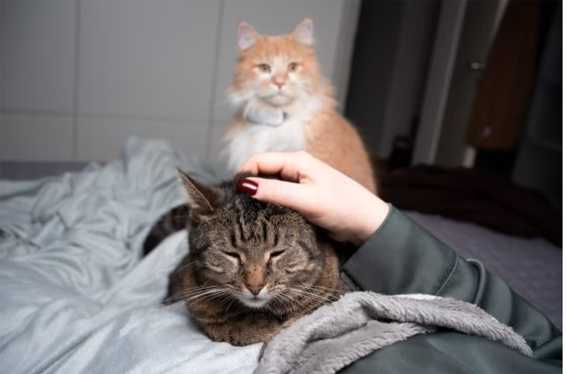DOES THE CAT GET JEALOUS? LET'S SEE TOGETHER THE CHARACTERISTICS OF OUR FRIENDS' AFFECTION
- Details
- Category: Feline news
- Hits: 115

Jealousy in cats is an interesting and controversial topic. Many cat owners claim to have noticed behaviors that could be interpreted as jealousy from their feline, but it is important to note that there is no scientific consensus on this issue.
Jealousy is a complex emotion that involves perceiving a threat to a significant bond and engaging in defensive behaviors to preserve that relationship. Many researchers believe that jealousy is a uniquely human trait and may not be present in animals, including cats.
When cats display behaviors that could be interpreted as jealousy, such as seeking attention when we pay attention to other animals or people, it could be explained by other factors, such as competition for resources, curiosity, or simply seeking interaction and attention.
Each cat has an individual personality and may react differently to social situations, but the interpretation of jealousy in cats should be done with caution and one should not overload these animals with human emotions.
In general, it is important to respect and satisfy the needs of our cats, providing them with adequate attention, care and interaction, without putting them in stressful or conflicting situations. By maintaining a stimulating and safe environment for your cat, we can help them live happy and fulfilling lives.
Cats can develop a strong, affectionate bond with their owners and with other people or animals they are in regular contact with. Although cats are often described as independent animals, many of them are affectionate and can show their attachment in different ways.
Here are some ways cats can show affection:
- Buzzing: The cat's buzzing is a sign of contentment and can be a way of expressing affection when they are in the company of loved ones.
- Purring: The cat may purr when being stroked or cuddled, and this can be interpreted as a manifestation of pleasure and affection.
- Licking: If a cat starts licking you, it could be a sign of affection. Cats lick each other for cleanliness and to strengthen social bonds, so doing the same to you could be a sign of appreciation.
- Hissing close: Some cats get very close to people they trust and rub against them. This is yet another expression of affection and recognition of the relationship.
- Follow and stay close: Affectionate cats may follow their owners around the house and try to be in their vicinity at all times, which shows their attachment and desire for companionship.
- Giving "prey": Some cats may bring objects such as toys or small prey (even if fake) to show their gratitude and affection.
- Stomach up: A cat showing its belly can be a sign of trust and affection, as exposing its belly is a vulnerable position for a cat.
It's important to note that cats can show their affection in different ways, and some breeds and individuals may be more inclined to be affectionate than others. Additionally, the relationship and affection between a cat and its owner can be influenced by the cat's history and life experiences.
To maintain and strengthen the emotional bond with your cat, it is essential to respect its spaces and needs, offering a safe environment, adequate nourishment, medical care, games and attention when required. Patience and mutual respect are key to building a loving relationship with your feline friend.
